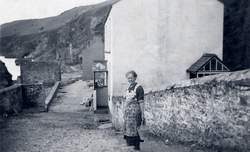Abandoned Communities ..... Hallsands
We will now return to 1917 and the fate of the villagers after the final abandonment of Hallsands. It was not in fact the case that everyone left. Two houses at a higher level than the others survived and have continued to be occupied. Elizabeth Prettejohn lived in one of them in 1917, when she was 33. She stayed there until her death in 1964. For many years she was happy to provide guided tours of the village ruins to interested tourists.
Apart from Elizabeth Prettejohn it appears that all the other villagers moved away. Some went to live with relatives or friends, but others had to take whatever accommodation they could find. Five men spent several months sleeping in a loft over a coach-house. When the weather was calm and warm some people would return to sleep in the ruins of their former homes. An additional problem for the fishermen was that their boats and equipment had been badly damaged in the storm of 17 January.
Very soon the question of compensation arose again. The Devon Sea Fisheries Committee wrote to the Board of Trade calling for full compensation, and on 7 March another Devon MP, Sir J Spear, raised the issue in Parliament. The Board of Trade appointed Sir Maurice Fitzmaurice to investigate and make recommendations. At the end of his enquiry he confirmed that the damage was entirely due to the dredging operations, and he recommended compensation as follows:
26 buildings £8000
Stores and gear £1250
Furniture and belongings £500
Drainage, water supply, and roads £750
The decision about the actual amount to be paid was not made until May 1918. Instead of the £10,500 recommended by Sir Maurice Fitzmaurice just £6000 was offered. A year later, as plans were being developed for new houses, a survey was carried out to establish the intentions of the dispossessed householders. It was found that four owners did not intend to return, seven wished to have thirteen houses for themselves and their families, and three were undecided. Eventually 10 houses, named Fordworth Cottages, were constructed a little way inland. They were ready for occupation in July 1924. They were not, however, given to their occupants. Instead, despite having owned their homes in Hallsands, the householders were required to pay rent for their new homes.
Some of the villagers were able to go on earning a living in the fishing industry. Two sisters, Ella and Patience Trout, not only carried on catching crabs, but also had the enterprise to open a guesthouse on the cliff top above Hallsands, carrying out much of the building work themselves. Ella had already made a name for herself in September 1917, when she rowed out to help rescue some of the sailors from the SS Newholm, a steamer that had been attacked by a German submarine. In 1933 the guest house was developed into the Prospect House Hotel, and more recently it has continued to be used as holiday apartments.
The story of Ella and Patience Trout has been told by Ruth and Frank Milton in their book Sisters Against the Sea: The Remarkable Story of Hallsands, Devon Books, 2005. The remains of the SS Newholm still lie in 39 metres of water off Start Point, sunk to the top of the boilers in the sand.
Apart from Elizabeth Prettejohn it appears that all the other villagers moved away. Some went to live with relatives or friends, but others had to take whatever accommodation they could find. Five men spent several months sleeping in a loft over a coach-
Very soon the question of compensation arose again. The Devon Sea Fisheries Committee wrote to the Board of Trade calling for full compensation, and on 7 March another Devon MP, Sir J Spear, raised the issue in Parliament. The Board of Trade appointed Sir Maurice Fitzmaurice to investigate and make recommendations. At the end of his enquiry he confirmed that the damage was entirely due to the dredging operations, and he recommended compensation as follows:
26 buildings £8000
Stores and gear £1250
Furniture and belongings £500
Drainage, water supply, and roads £750
The decision about the actual amount to be paid was not made until May 1918. Instead of the £10,500 recommended by Sir Maurice Fitzmaurice just £6000 was offered. A year later, as plans were being developed for new houses, a survey was carried out to establish the intentions of the dispossessed householders. It was found that four owners did not intend to return, seven wished to have thirteen houses for themselves and their families, and three were undecided. Eventually 10 houses, named Fordworth Cottages, were constructed a little way inland. They were ready for occupation in July 1924. They were not, however, given to their occupants. Instead, despite having owned their homes in Hallsands, the householders were required to pay rent for their new homes.
Some of the villagers were able to go on earning a living in the fishing industry. Two sisters, Ella and Patience Trout, not only carried on catching crabs, but also had the enterprise to open a guesthouse on the cliff top above Hallsands, carrying out much of the building work themselves. Ella had already made a name for herself in September 1917, when she rowed out to help rescue some of the sailors from the SS Newholm, a steamer that had been attacked by a German submarine. In 1933 the guest house was developed into the Prospect House Hotel, and more recently it has continued to be used as holiday apartments.
The story of Ella and Patience Trout has been told by Ruth and Frank Milton in their book Sisters Against the Sea: The Remarkable Story of Hallsands, Devon Books, 2005. The remains of the SS Newholm still lie in 39 metres of water off Start Point, sunk to the top of the boilers in the sand.
Six
Elizabeth Prettejohn
Fordworth Cottages in April 2007

